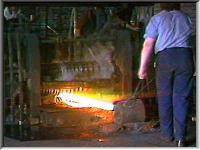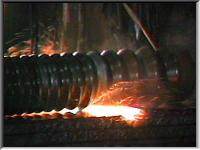John Bradley Ironworks
Iron & Steel Making Feature
John Bradley Ironworks
Iron & Steel Making Feature
Background
John Bradley established his famous foundry and rolling mill beside the Stourbridge Canal at Wollaston in 1800.
In 1819, John Rastrick joined the firm and designed the "New Foundry" which was completed in 1820 and included a magnificent iron roof with cast iron tie-bars and wrought iron rafters.

The works became well-known for the quality of its cast and rolled iron and supplied a large proportion of the fish-bellied rail for the Liverpool and Manchester Railway.
Rastrick's locomotives Agenoria and Stourbridge Lion were built here in 1828.
The Stourbridge Lion and two other locomotives were exported to America the following year.

When I.A.Recordings started serious recording work in 1982, the rolling mill at John Bradley's was our first industrial archaeology rescue recording project. W.K.V.Gale, one of the foremost historians of the British iron and steel industry asked us to visit the works in May to record as much as possible before it closed.
At one time, there were over 300 hand steel rolling mills in the Black Country, but this was the last one and it closed just three days after our visit.

The video production Hand Rolling of Steel, scripted and narrated by W.K.V.Gale, follows the process from the stockpile of steel billets.
The billet is cold sheared and re-heated to 1,200oC, then rolled in nine passes in a mixture of two-high and three-high rolls. The resulting 20 metre long sections are then cold-straightened, cut to length and bundled to form the finished product.
The mill was driven by a 260 kW G.E.C. electric motor with a 25 tonne flywheel, installed in 1927.
The works was situated at NGR: SO 895 848
The images on this page are taken from the Production - "Hand Rolling of Steel"

